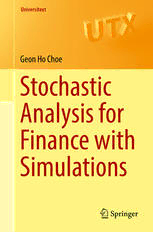Table Of ContentUniversitext
Geon Ho Choe
Stochastic
Analysis for
Finance with
Simulations
Universitext
Universitext
SeriesEditors:
SheldonAxler
SanFranciscoStateUniversity,SanFrancisco,CA,USA
VincenzoCapasso
Universita` degliStudidiMilano,Milano,Italy
CarlesCasacuberta
UniversitatdeBarcelona,Barcelona,Spain
AngusMacIntyre
QueenMaryUniversityofLondon,London,UK
KennethRibet
UniversityofCalifornia,Berkeley,CA,USA
ClaudeSabbah
CNRS,E´colePolytechnique,Palaiseau,France
EndreSu¨li
UniversityofOxford,Oxford,UK
WojborA.Woyczyn´ski
CaseWesternReserveUniversity,Cleveland,OH,USA
Universitext is a series of textbooksthat presents material from a wide variety of
mathematicaldisciplinesatmaster’slevelandbeyond.Thebooks,oftenwellclass-
testedbytheirauthor,mayhaveaninformal,personalevenexperimentalapproach
to their subject matter. Some of the most successful and established books in the
series have evolved through several editions, always following the evolution of
teachingcurricula,toverypolishedtexts.
Thus as research topics trickle down into graduate-level teaching, first textbooks
writtenfornew,cutting-edgecoursesmaymaketheirwayintoUniversitext.
Moreinformationaboutthisseriesathttp://www.springer.com/series/223
Geon Ho Choe
Stochastic Analysis for
Finance with Simulations
123
GeonHoChoe
DepartmentofMathematicalSciences
andGraduateSchoolofFinance
KoreaAdvancedInstituteofScience
andTechnology
Yuseong-gu,Daejeon
RepublicofKorea
ISSN0172-5939 ISSN2191-6675 (electronic)
Universitext
ISBN978-3-319-25587-3 ISBN978-3-319-25589-7 (eBook)
DOI10.1007/978-3-319-25589-7
LibraryofCongressControlNumber:2016939955
MathematicsSubjectClassification:91Gxx,91G10,91G20,91G30,91G60,91G70,91G80
©SpringerInternationalPublishingSwitzerland2016
Thisworkissubjecttocopyright.AllrightsarereservedbythePublisher,whetherthewholeorpartof
thematerialisconcerned,specificallytherightsoftranslation,reprinting,reuseofillustrations,recitation,
broadcasting,reproductiononmicrofilmsorinanyotherphysicalway,andtransmissionorinformation
storageandretrieval,electronicadaptation,computersoftware,orbysimilarordissimilarmethodology
nowknownorhereafterdeveloped.
Theuseofgeneraldescriptivenames,registerednames,trademarks,servicemarks,etc.inthispublication
doesnotimply,evenintheabsenceofaspecificstatement,thatsuchnamesareexemptfromtherelevant
protectivelawsandregulationsandthereforefreeforgeneraluse.
Thepublisher,theauthorsandtheeditorsaresafetoassumethattheadviceandinformationinthisbook
arebelievedtobetrueandaccurateatthedateofpublication.Neitherthepublishernortheauthorsor
theeditorsgiveawarranty,expressorimplied,withrespecttothematerialcontainedhereinorforany
errorsoromissionsthatmayhavebeenmade.
Printedonacid-freepaper
ThisSpringerimprintispublishedbySpringerNature
TheregisteredcompanyisSpringerInternationalPublishingAGSwitzerland
Preface
Thisbookisanintroductiontostochasticanalysisandquantitativefinance,includ-
ingtheoreticalandcomputationalmethods,foradvancedundergraduateandgradu-
atestudentsinmathematicsandbusiness,butnotexcludingpractitionersinfinance
industry.Thebookisdesignedforreaderswhowanttohaveadeeperunderstanding
of the delicate theory of quantitative finance by doing computer simulations in
addition to theoretical study. Topics include stochastic calculus, option pricing,
optimal portfolio investment, and interest rate models. Also included are simula-
tions of stochastic phenomena,numericalsolutions of the Black–Scholes–Merton
equation,MonteCarlomethods,andtimeseries.Basicmeasuretheoryisusedasa
tool to describe probabilistic phenomena. The level of familiarity with computer
programming is kept to a minimum. To make the book accessible to a wider
audience,somebackgroundmathematicalfactsareincludedinthefirstpartofthe
bookandalsointheappendices.
Financial contracts are divided into two groups: The first group consists of
primaryassetssuchassharesofstock,bonds,commodities,andforeigncurrencies.
Thesecondgroupcontainsfinancialderivativessuchasoptionsandfuturesonthe
underlying assets belonging to the first group. A financial derivative is a contract
thatpromisespaymentincashordeliveryofanassetcontingentonthebehaviorof
theunderlyingassetinthefuture.Thegoalofthisbookistopresentmathematical
methods for finding how much one should pay for a financial derivative. To
understandtheoptionpricingtheoryweneedideasfromvariousdisciplinesranging
overpureandappliedmathematics,nottomentionfinanceitself.We trytobridge
thegapbetweenmathematicsandfinancebyusingdiagrams,graphsandsimulations
inadditiontorigoroustheoreticalexposition.Simulationsinthisbookarenotonly
usedasthecomputationalmethodinquantitativefinance,butcanalsofacilitatean
intuitiveanddeeperunderstandingoftheoreticalconcepts.
SincethepublicationsbyBlack,ScholesandMertononoptionpricingin1973,
thetheoryof stochasticcalculus,developedbyItoˆ,hasbecomethefoundationfor
anewfieldcalledquantitativefinance.Inthisbookstochasticcalculusispresented
startingfromthetheoreticalfoundation.Afterintroducingsomefundamentalideas
in quantitative finance in Part I, we present mathematical prerequisites such as
v
vi Preface
Lebesgueintegration,basicprobabilitytheory,conditionalexpectationandstochas-
tic processes in Part II. After that, fundamental properties of Brownian motion,
the Girsanov theorem and the reflection principle are given in Part III. In Part IV
we introducethe Itoˆ integralandItoˆ’slemma, andthenpresentthe Feynman–Kac
theorem.InPartVwepresentthreemethodsforpricingoptions:thebinomialtree
method,theBlack–Scholes–Mertonpartialdifferentialequation,andthemartingale
method. In Part VI we analyze more examples of the martingale method, and
study exotic options, American options and numeraire. In Part VII the variance
minimization methodfor optimal portfolioinvestmentis introducedfor a discrete
time model. In Part VIII some interest rate models are introduced and used in
pricingbonds.InPartIXtheNewton–Raphsonmethodoffindingimpliedvolatility,
time series models for estimating volatility, Monte Carlo methods for option
prices, numerical solution of the Black–Scholes–Merton equation, and numerical
solutionofstochasticdifferentialequationsareintroduced.Intheappendicessome
mathematical prerequisites are presented which are necessary to understand the
material in the main chapters, such as point set topology,linear algebra, ordinary
differentialequations, and partial differentialequations. The graphs and diagrams
in thisbookwereplottedby the authorusingMATLAB and AdobeIllustrator,and
thesimulationsweredoneusingMATLAB.
Comments from the readers are welcome. For corrections and updates please
checkauthor’shomepagehttp://shannon.kaist.ac.kr/choe/orsendanemail.
ThisworkwaspartiallysupportedbyBasic ScienceResearchProgramthrough
the National Research Foundation of Korea (NRF) funded by the Ministry of
Science,ICTandFuturePlanning(NRF-2015R1A2A2A01006176).
GeonH.Choe
Acknowledgements
The author wishes to thank Colin Atkinson, Suk Joon Byun, Dong-Pyo Chi,
Hyeong-InChoi,DongMyungChung,DanCrisan,OleHald,YujiIto,SunYoung
Jang, Intae Jeon, Duk Bin Jun, Byung-Chun Kim, Dohan Kim, Hong Jong Kim,
JaewanKim,KyungSooKim,MinhyongKim,SolKim,SoonKiKim,TongSuk
Kim, Ohsang Kwon, Yong Hoon Kwon, Jong Hoon Oh, Hyungju Park, Andrea
Pascucci, Barnaby Sheppard, Sujin Shin, Ravi Shukla, Insuk Wee, Harry Zheng,
andallhiscolleaguesintheDepartmentofMathematicalSciencesandtheGraduate
SchoolofFinanceatKAIST.
He wishes to thank YounghoAhn, Soeun Choi, Hyun Jin Jang, Myeong Geun
Jeong,MihyunKang,Bong Jo Kim, ChihurnKim, DongHan Kim, KunheeKim,
KiHwanKoo,SoonWonKwon,DongMinLee,KyungsubLee,YoungHoonNa,
Jong Jun Park, Minseok Park, Byung Ki Seo and Seongjun Yoon. He also thanks
many students who took various courses on quantitative finance taught over the
years.
The author thanks the editors Joerg Sixt, Re´mi Lodh and Catriona Byrne, and
the staff at Springer, including Catherine Waite. He is also grateful to several
anonymousreviewers who gave many helpful suggestions. The author thanks his
mother and mother-in-law for their love and care. Finally, he wishes to thank his
wifeforherloveandpatience.
vii
Contents
PartI IntroductiontoFinancialMathematics
1 FundamentalConcepts ..................................................... 3
1.1 Risk...................................................................... 3
1.2 TimeValueofMoney................................................... 4
1.3 NoArbitragePrinciple.................................................. 4
1.4 ArbitrageFreeMarket.................................................. 5
1.5 Risk-NeutralPricingandMartingaleMeasures....................... 10
1.6 TheOnePeriodBinomialTreeModel................................. 11
1.7 ModelsinFinance ...................................................... 13
2 FinancialDerivatives........................................................ 15
2.1 ForwardContractsandFutures......................................... 15
2.2 Options.................................................................. 16
2.3 Put-CallParity .......................................................... 19
2.4 RelationsAmongOptionPricingMethods............................ 20
PartII ProbabilityTheory
3 TheLebesgueIntegral ...................................................... 25
3.1 Measures ................................................................ 25
3.2 SimpleFunctions........................................................ 28
3.3 TheLebesgueIntegral.................................................. 29
3.4 Inequalities.............................................................. 34
3.5 TheRadon–NikodymTheorem ........................................ 36
3.6 ComputerExperiments................................................. 37
4 BasicProbabilityTheory ................................................... 41
4.1 MeasureandProbability................................................ 41
4.2 CharacteristicFunctions................................................ 46
4.3 IndependentRandomVariables........................................ 50
4.4 ChangeofVariables..................................................... 56
4.5 TheLawofLargeNumbers............................................ 60
4.6 TheCentralLimitTheorem ............................................ 62
ix

